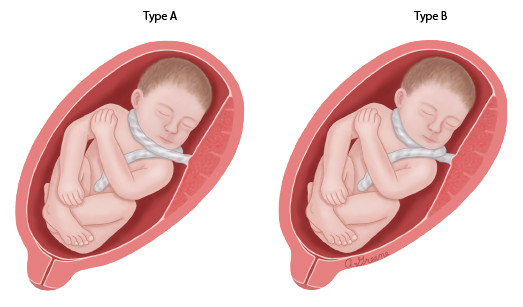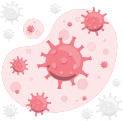The umbilical cord supplies blood, oxygen, and nutrients needed by the fetus from the mother during pregnancy. The umbilical cord connects the mother to the placenta and contains blood vessels (2 arteries and 1 vein).
After the baby is born, the umbilical cord is no longer needed, and the doctor will cut it, leaving a small piece of the cord attached to the baby's navel. This piece will dry up naturally and fall off within a few weeks after birth.
Definition
A nuchal cord occurs when the umbilical cord wraps around the fetus's neck inside the uterus. This condition is quite common and does not always cause health problems, but in some rare cases, it can lead to serious complications.
If the umbilical cord wraps around the fetus's neck one or more times, it is referred to as a nuchal cord. Nuchal cords are categorized into two types: Type A and Type B. Type A, also known as unlocked cords, are free to move and can spontaneously loosen; Type B, or locked cords, do not release naturally except in certain cases.
This condition is almost never dangerous. If it happens, the mother may not be informed during labor unless there are complications. A baby may have the umbilical cord wrapped around its neck multiple times, and the condition is still fine.
Causes
The most common cause of a nuchal cord is fetal movement before birth. Additionally, an excess amount of amniotic fluid can allow the fetus to move more freely, and a longer than average umbilical cord can also contribute to the occurrence of a nuchal cord.
Risk Factor
Several factors can increase the risk of a nuchal cord, including
- Multiple pregnancies: higher risk if the mother is carrying twins or more.
- Prolonged pregnancy (gestational age over 40 weeks): the longer the fetus remains in the womb, the greater the risk of the umbilical cord wrapping around the neck.
- Male fetus: male fetuses are generally more likely to be born with a nuchal cord compared to female fetuses.
- Excessive amniotic fluid: this allows the fetus to move more freely, increasing the risk of the umbilical cord wrapping around the neck.
- Long or poorly structured umbilical cord: these factors can also increase the risk of a nuchal cord.
Symptoms
A nuchal cord does not cause visible symptoms. There will be no noticeable changes in your body or pregnancy symptoms. However, it's important to monitor the frequency of fetal movements daily. If the movements decrease, the mother should be aware and consult a doctor immediately.
Diagnosis
A nuchal cord is usually discovered during a routine pregnancy ultrasound, unless the fetus has an abnormal heart rate. The diagnosis of a nuchal cord can only be made with an ultrasound examination.
In addition, an ultrasound can only identify the presence of a nuchal cord; it cannot determine whether the nuchal cord poses a risk to the fetus.
If you are diagnosed with a nuchal cord early in pregnancy, the important thing to remember is not to panic. The nuchal cord may loosen before delivery. If it does not, the baby can still be born safely. The doctor will monitor for the possibility of a nuchal cord during labor and will provide extra supervision if there is a risk of complications.
Management
There is currently no treatment or prevention for nuchal cord. No specific medical intervention or care can be done until delivery. In special cases, the doctor may recommend a cesarean section if they feel that the fetus is in distress or that the mother's health could be compromised during a vaginal delivery.
Most mothers do not need special preparation before delivery. If a nuchal cord is found around the fetus's neck, the doctor will discuss what needs to be observed. During labor, the doctor will check the umbilical cord around the neck by gently moving it so it does not constrict the area around the baby's neck as the baby begins to breathe. If a nuchal cord is diagnosed before delivery, the mother will receive extra monitoring during labor to ensure there is no fetal distress.
Complications
Complications from a nuchal cord are very rare. The most important thing to note is to manage stress levels in the mother, as stress can affect the pregnancy. Complications usually occur during labor; during birth, the umbilical cord may be slightly compressed during contractions, reducing the amount of blood pumped to the fetus.
This can cause the fetal heart rate (FHR) to decrease. If the FHR continues to decrease, the mother will be asked to try different labor positions, and the doctor may recommend a cesarean section to deliver the baby.
In rare cases, a nuchal cord can lead to decreased fetal movement and hinder fetal development if it occurs early in pregnancy. Other potential complications include:
- Cord entanglement
- Reduced amniotic fluid
- Intrauterine growth restriction (IUGR)
- Anemia
- Low blood circulation (hypovolemia)
- High blood acidity (metabolic acidosis)
You can learn more about fetal growth restriction here: Intrauterine Growth Restriction (IUGR) - Definition, Cause, Symptoms, And Treatment.
Prevention
There is currently no treatment or prevention for a nuchal cord, as the condition does not have visible symptoms. There will be no noticeable changes in the mother's body or pregnancy symptoms.
It is important to remember that if a pregnant mother is diagnosed with a nuchal cord, she should not panic and should discuss with her doctor the steps to take for a safe delivery. There is nothing wrong with the pregnant mother that causes this condition. Panic and stress can negatively impact the pregnancy and the fetus.
When to See a Doctor?
A nuchal cord occurs without visible symptoms in the pregnant mother and is usually diagnosed during routine pregnancy ultrasounds. It is best to discuss with your doctor if this condition is found during an examination. Consult with your doctor regarding any questions and concerns you may have when you learn about the presence of a nuchal cord in your baby.
Looking for more information about other diseases? Click here!
- dr Anita Larasati Priyono
How Does Nuchal Cord Affect My Baby. (2017). Retrieved 05 December 2022, from https://www.healthline.com/health/pregnancy/nuchal-cord
Umbilical Cord Care. (2022). Retrieved 05 December 2022, from https://my.clevelandclinic.org/health/treatments/11308-umbilical-cord-appearance-and-care
What to Know About a Nuchal Cord. (2021). Retrieved 05 December 2022, from https://www.webmd.com/baby/what-to-know-about-nuchal-cord
Everything you Need to Know About Nuchal Chord. (2017). Retrieved 05 December 2022, from https://www.medicalnewstoday.com/articles/319762
What Happens if the Umbilical Cord is Around my Baby’s Neck?. (2018). Retrieved 05 December 2022, from https://utswmed.org/medblog/nuchal-cord-during-pregnancy/







